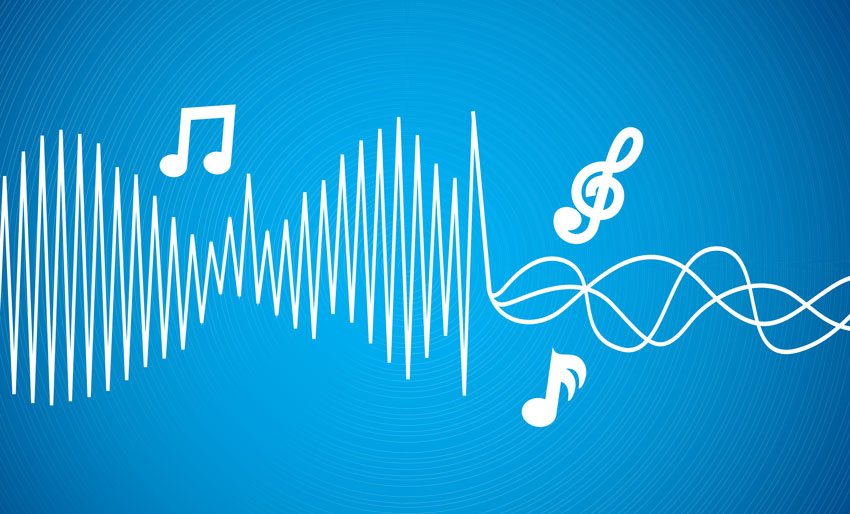Sound, soundwaves, frequencies… these are often very hard concepts for musicians to get their head around, normally explained using a very complicated and scientific language. Surely I’m not the only person who imagines the sound as circles starting small and getting bigger, like when you throw something in the water, right? Well, that’s true – but it’s just the part of the bigger and more interesting truth…
As a musician with well-trained ears you are constantly aware of the sounds around you, whether musical or not. For that reason it’s worth getting to really know what’s going on in this world of soundwaves and audio frequencies.
What our brain interprets as sound is actually the movement of air molecules. Much like the water: you disturb the surface of the water with some stone (or the body of your best friend) and those waves appear, as one molecule disturbs the molecules beside it and so on. It’s like dominos, when all the pieces fall one after another as soon as one single domino piece starts the process. The word “frequency” is used to describe the speed or the rate of that “process of disturbing”: how fast the particles move, meaning how often one particle disturbs the other particle from point A to point B by thus creating those waves.
Our brains, colours and sounds
The most interesting thing about sound is: it is all in your head (as the Cranberries tried to tell us). That doesn’t mean we are all zombies, it just means those waves of disturbance in the air enter our ear, they are processed there, then they are turned into electrical(!) impulses, and our brain interprets those waves as what we call sound. Astonishing!
Humans perceive those waves as sound, and other animals perceive it in a different way. For example scorpions, snakes and other types of animals experience those sound waves through special hair on their body, through their tongues or other organs, and it probably doesn’t seem quite like what we know of as “sound” to them.
If the frequency of those waves is low, the pitch normally sounds low to us, too. When that speed gets higher, we call it a high-pitched sound (think of bassoon vs. piccolo sounds, for example, and everything in between). And when the frequency is too low or too high, our ears and brain cannot even translate that into sounds for us, but the waves are still technically there. And they can have an impact on your body even if you don’t hear them.
I personally can hear between around 90 to 15,000 Hertz (Hertz is how we measure the frequencies, like how we use centimeters for lengths).
What about you? Try out this test and leave your answer in the comments.
Note: if you were to take the same test ten years later, you probably won’t be able to hear the same range anymore. Sadly we lose our range of frequency hearing over time.

Here’s another astonishing fact: everything around us vibrates. Our body, objects around us, Earth… We also see colours for the same reason: light can be interpreted as vibrations/waves too. When the frequency is slow, we see “darker” colours (say violet or blue), and when the vibration is fast, we see other, one might say more “vivid” colours (say yellow and red). Everything has its own rate of vibration, and humans have learned to play with these to make very cool (as well as very uncool and destructive) things.
When you match the frequency of an object with a sound source and organise an “interaction” between the two you can distort the object itself! In the classic example of a singer breaking a wine glass, this is how it happens. And scientists have even come up with weapons that use sound to cause pain, hurt your ears, eyes and your entire body! So that old Bible story about destroying the walls of Jericho by only making noise might yet come about in the future.
So, although what we enjoy as sound is the result of the work of our ears and brains, the vibrations themselves are real, and whether it’s sound (pitch) or light (colour), it’s their frequency (the speed of particles moving around) plus the work of our brains which create the final product.
It’s quite interesting to note that a lot which has to do with music can actually be compared to colours. Ancient Greeks enjoyed doing this a lot, and we do it now too. “Chroma” means colour so the chromatic scale, for instance, could as well be called the “colourful scale”. And we use the word “tone” both to describe sounds, as well as colours. Even colour words themselves are used both for actual visual colours and for musical sounds! Many composers used colour words to describe musical keys, the modes, their works. For example, guess what these three B’s have in common: Beethoven, B minor, black. Yes, Beethoven once described B minor as black/dark (big B was himself often moody and all)… But it’s all quite subjective, and personally I don’t hear any blackness in B minor myself, at least for now.
Sounds We Love and Sounds We Hate
So pitches are made of frequencies. When human beings sing we generally ever reproduce very precise frequencies. You’ll always wander around certain frequencies when trying to hit a particular pitch, but the human voice will struggle to reproduce 440 hertz exactly. And it’s important to remember that pitch doesn’t exactly equal frequency. For example, it might sound like you are singing the same pitch as 440 Hertz – but your voice will actually be producing a large number of different frequencies as part of its timbre. And the brain is quite good at “rounding” pitches to the nearest musical note, so that you needn’t hit the exact specific target pitch in order to sound like you are singing the corresponding note.
In some musical traditions, there are smaller steps than semitones used, and many musicians play around with this. If you haven’t heard this kind of “microtonal” music before, it may sound out of tune to you, or you may not find it too enjoyable. However, it’s OK to “search for the note” in your head and adjust your own voice as you sing. You shouldn’t torture yourself with trying to “sound like” the exact sound you aim for in terms of precise frequency. It’s about being within a certain range of frequencies, not an absolutely precise one.
So, what do these frequencies translate into in our daily lives? How do we actually experience frequencies?
We’ve learned about the measurement unit of “Hertz” above, and so we can think about how we experience pitch in terms of Hertz. When the number of Hertz is high (meaning the frequency is fast), for us it normally means the pitch is high.
Another aspect which is important for us is the loudness or the quietness of the sound, right? Hit one piano key very softly. Then hit the same key hard. It’s the same pitch, the same frequency, but something else about the note has changed. This loudness is measured with a unit called Decibels, and it does not affect the frequency in Hertz. Two different sounds can have the same frequency but different volumes, or the same volume but different frequencies.
We’ve talked about how frequency implies pitch, and that makes it fundamental to musical sounds. But what about other sounds we hear each day? Frequency has a big impact there too.
For example, here’s an interesting list of the top “most hated” and “most pleasant” sounds:
Ten sounds people hate the most
Source: MedicalNewsToday.com
- A knife scraping against a bottle.
- A fork on a glass.
- Chalk on a blackboard.
- A ruler on a bottle.
- Nails on a blackboard.
- A female scream (sorry ladies!).
- An anglegrinder.
- Brakes on a cycle squealing.
- A baby crying.
- An electric drill.
Most pleasing sounds
- Applause.
- A baby laughing.
- Thunder.
- Water flowing
So why do we find some of those sounds pleasing whilst others are so distressing that we get goosebumps? Well, the answer starts with an F… That’s it! Our brains are responding to certain frequencies in certain ways!
According to one reasonable-sounding theory, evolution and our own experiences have produced these reactions for us: babies’ crying and women’s screams may sound distressful because survival of early communities depended on these two groups in the very remote past, so our brains have learned to respond to these sounds in a strong and disruptive way. According to one study conducted by musicologists Michael Oehler and Christoph Reuters, the sounds we hate the most lay in the frequency range 2000 to 4000 Hertz.
Useful information for everyone producing their own music, right? There’s a lot more to it than just which notes you choose…
For a full introduction to audio frequencies, click here
I hope you’ve enjoyed this brief and fun introduction to the importance of sound waves and frequencies in our lives. I’ll leave you with a video of some very cool things you can do with sound…







